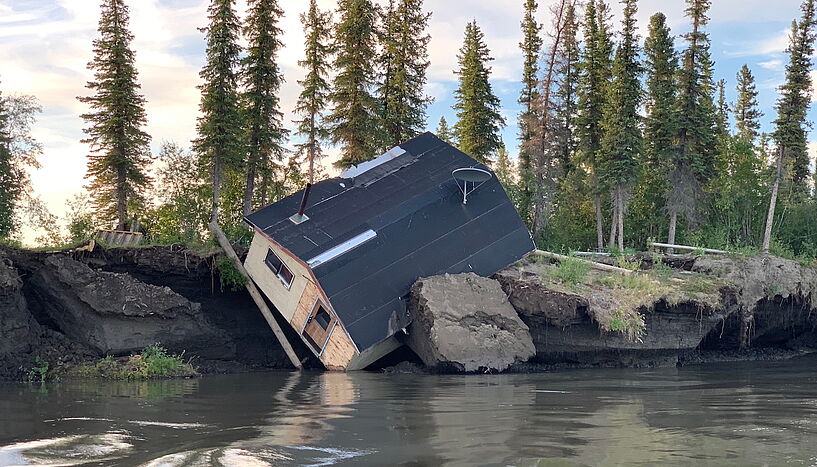Thawing permafrost threatens up to three million people in Arctic regions
16. January 2025
Fig. 1: Infrastructure in permafrost areas is threatened by river bank erosion, Mackenzie River Delta, Canada. C: Angus Alunik, 2021
First comprehensive pan-Arctic study of social impacts of thawing permafrost soils
In an interdisciplinary and transdisciplinary study, an international team led by the University of Vienna and the Danish Technical University/Umea University examined the social risks for Arctic regions associated with thawing permafrost. They identified five key risks related to infrastructure, transport and supply, water quality, food security and health. The scientists found that the thawing permafrost posed an increased risk of exposure to infectious diseases and release of contaminants, and interruptions of supply routes. The study has been published in the renowned journal Communications Earth and Environment.
The thawing of permafrost poses various risks to the Arctic environment and the livelihoods of people. Increasingly thawing permafrost soils not only pose a global threat due to the CO2 and methane gas stored in them, but also have far-reaching implications for the approximately three million Arctic residents who live on permafrost soils. Understanding these risks is crucial for informed policy planning and adaptation measures. To identify these risks, the scientists studied four Arctic regions between 2017 and 2023 as part of the "Nunataryuk" project: Longyearbyen (Svalbard, Norway), the municipality of Avannaata (Greenland), the Beaufort Sea region the Mackenzie River Delta (Canada) and the Bulunskiy district in the Republic of Sakha (Russia). The team included engineering and physics scientists as well as environmental, social and health scientists. "The comprehensive risk analysis was made possible by intensive exchange with local stakeholders and permafrost scientists, and for the first time includes not only physical processes but also a comprehensive overview of social impacts of thawing permafrost soils," explains anthropologist and co-study director Susanna Gartler from the University of Vienna.
The researchers identified five interrelated key hazards: infrastructure failure, disruption of mobility and supply, decreased water quality, challenges for food security, and exposure to diseases and contaminants. Infrastructure in coastal areas, along rivers, in deltas and mountainous regions is particularly at risk. As one study participant reported, "I have a camp by the river. This summer, a large piece of land next to my cabin broke off and plunged into the river. It's scary." Some erosion is slow, but in delta regions, large chunks of land can break off literally overnight. In terms of health and ecosystems, there is concern for contaminants from old oil and gas sumps being released by thawing soils. Historically, the industry left waste in the ground, assuming that the soils would remain permanently frozen – a fact that is now changing dramatically with increasing global warming.
In Canada and other regions where the population is heavily dependent on hunting and fishing, erosion also affects food security as hunting and fishing cabins become more difficult to reach, soils turn to quicksand and thaw slumps (a type of landslide) must be avoided. In Longyearbyen on Svalbard, the thawing of the permafrost also threatens access to clean drinking water, as the dam of the main source, Isdammen, is built on frozen ground. This is a major concern for the health and well-being of the local population. In the follow-up project ILLUQ, the scientists are now investigating the complex of topics related to permafrost, health and pollution.
Original publication:
Susanna Gartler, Johanna Scheer, Alexandra Meyer, Khaled Abass, Annett Bartsch, Natalia Doloisio, Jade Falardeau, Gustaf Hugelius, Anna Irrgang, Jón Haukur Ingimundarson, Leneisja Jungsberg, Hugues Lantuit, Joan Nymand Larsen, Rachele Lodi, Victoria Sophie Martin, Louise Mercer, David Nielsen, Paul Overduin, Olga Povoroznyuk, Arja Rautio, Peter Schweitzer, Niek Jesse Speetjens, Soňa Tomaškovičová, Ulla Timlin, Jean-Paul Vanderlinden, Jorien Vonk, Levi Westerveld, und Thomas Ingeman-Nielsen: A transdisciplinary, comparative analysis reveals key risks from Arctic permafrost thaw. In: Communications Earth and Environment (2025).
Picture:
Fig. 1: Infrastructure in permafrost areas is threatened by river bank erosion, Mackenzie River Delta, Canada. C: Angus Alunik, 2021
Scientific contact
Susanna Gartler
Institut für Kultur- und SozialanthropologieUniversität Wien
1010 - Wien, Universitätsstrasse 7 (NIG), A0404
+436504690230
susanna.gartler@univie.ac.at
Further inquiry
Theresa Bittermann
Media Relations, Universität Wien1010 - Wien, Universitätsring 1
+43-1-4277-17541
theresa.bittermann@univie.ac.at
Downloads:
202411xx_Gartler_Abb1_01.jpg
File size: 3,47 MB
